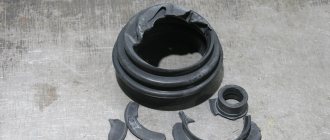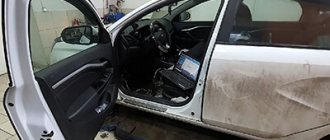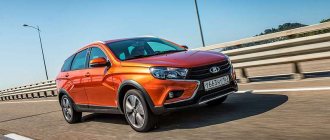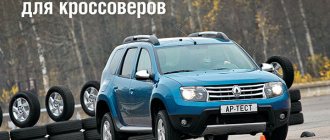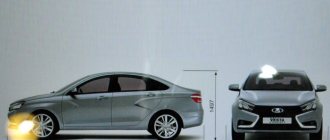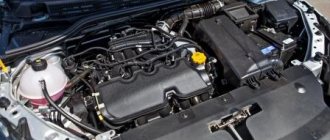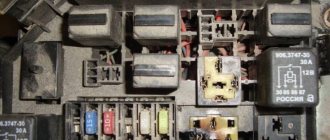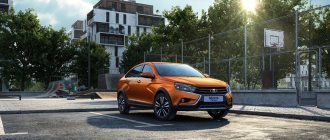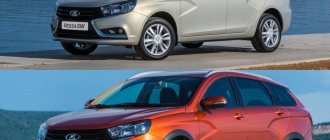Active vehicle safety includes electronics that help prevent an accident. Lada Vesta is equipped with many assistants that help maintain vehicle controllability when traveling. Among other things, the driver should know how the traction control system of the Lada Vesta works.
To move a car, grip on the road is important. But its reliability drops significantly if the road is wet or slippery, which increases the likelihood of slipping. It causes problems such as:
- loss of dynamics during acceleration;
- poor handling;
- high probability of skidding;
- increased tire wear.
The directional stability system on the Lada Vesta works in conjunction with traction control system (TCS), which allows the driver to move away on a slippery surface with minimal chance of slipping.
In reality, it looks like this: if the wheel begins to rotate too quickly during acceleration, the traction system is activated and takes corrective measures: braking or reducing the transmitted torque. At the same time, the car remains stable.
On a note!
On the Lada Vesta, anti-booking works in all trim levels.
Reliability of TCS on Lada Vesta
Each vehicle stabilization system was tested under different road surface conditions (wet asphalt, slush, ice, etc.). The TCS traction control system has shown its best side: it “intervenes” only when necessary and works well with other electronics.
The owners are also mostly satisfied, although some took time to adapt to all the functionality of Vesta.
On a note!
It’s better to think several times before turning off the TCS. Electronic safety systems, including Lada Vesta anti-skid, increase your chances of a successful outcome of a dangerous situation on the road. And even under normal driving conditions, you can feel more confident knowing that there is such a safety net.
The Lada Vesta car is equipped with all the most necessary systems that contribute to comfortable driving. All of the systems listed below are present in absolutely all trim levels of the car, which makes it a very attractive figure on the car market. ABS or anti-lock braking system
- in the event of emergency and sometimes regular braking, it prevents the car’s wheels from completely blocking. Thanks to this system, the braking distance of the car is reduced, and during braking it is possible to control the car due to the fact that the wheels are not blocked. When this system operates, you will probably hear a characteristic “crackling” sound and a slight beating of the brake pedal.
EBD or brake force distribution
- correctly distributes the braking forces of the front and rear axles of the car, the system is activated when the ABS is not working correctly, and is indicated on the dashboard as a red indicator - “Brake failure”.
BA or Brake Assist
— this function reads how quickly you pressed the brake pedal; from the data received, the system recognizes whether it was normal braking or emergency braking. In the event of emergency braking, the system will increase the pressure in the brake system drive to a certain level and will maintain it as long as the brake pedal is pressed.
HHC or preventing the car from rolling away when starting off on an incline
- When stopping the vehicle on a slope of four percent or more, the HHC system is activated to help the vehicle continue to move forward, so that the HHC operates correctly, press the brake pedal with sufficient force to ensure that the vehicle remains stationary once the gear is engaged, releasing the brake pedal and pressing the accelerator pedal, the system will hold the car in place until it starts moving, but no more than two seconds. The system automatically turns off if the car is on the parking brake or the driver's door of the car is open.
ESC and TC - or stability control and traction control
— these two car functions work in tandem and are activated automatically when the car engine is turned on. ESC is responsible for the reliable stability of the car on the road, the system reads the rotation speed of all wheels and if one or more of them starts to rotate faster, the system slows down their rotation; in more serious situations, the system resets the engine speed, thanks to which it returns controllability of the car. TC performs the same functions as ESC only when the vehicle is moving off, which reduces excessive wheel slip of the vehicle.
| Photo "b" |
ESC and TC, unlike other car functions, have the ability to be switched off forcibly.
The driver may need to disable these systems when driving in difficult terrain. In order to turn off the systems, you must press and hold the button shown in photo “a” for one second. If you did everything correctly, an icon will light up on the dashboard indicating that ESC and TC have been disabled (photo “b”). Disabling these systems is possible only if the vehicle speed does not exceed 50 kilometers; at this speed mark the systems are turned on automatically. abbreviations
Questions & Answers
abbreviations
ESC (Electronic Stability Control). See ESC
ESC (Electronic Stability Control) - Electronic stability control.
ESP ® (Electronic Stability Program) - BOSCH electronic stabilization program. See ESC.
ABS (Anti-lock Braking System)
An automated system that prevents the car's wheels from locking in the event of braking. The main task of the system is to ensure vehicle controllability during sudden braking.
ASR (Antriebs Schlupf Regelung) - Anti-slip system (ATS)
A logical continuation of the development of the ABS anti-lock braking system. This system greatly simplifies driving on wet or wet roads. See TCS
TCS (Traction Control System) - Traction Control / Traction Control System
An electro-hydraulic vehicle system designed to prevent loss of traction by controlling the slip of the drive wheels. Activated when one of the drive wheels tends to slip.
BAS (Brake Assist System) - Emergency Brake Assist
The system is designed to assist during extreme braking. Works in conjunction with ABS and EBD systems. The system evaluates how fast the brake pedal was pressed; other sensors record the speed of rotation of the wheel and the speed of the vehicle. If the speed is high and the brake pedal is pressed very quickly, then the BAS system forces the brakes to work at full power, but without blocking the ABS.
HSA (Hill Start Assist) - Hill Start Assist System
Makes starting easier by maintaining brake pressure for about 2 seconds after releasing the brake pedal. The driver has enough time to move his foot from the brake pedal to the gas pedal without using the handbrake. The car moves off calmly without rolling back, which greatly increases the comfort and safety of driving.
TPMS (Tires Pressure Monitoring System) - Tire pressure monitoring system
Designed to warn of dangerous changes in tire pressure. A drop in tire pressure entails a change in the angular speed of the wheel. By comparing wheel speeds, a potentially deflated tire is identified. This optional feature allows you to monitor tire pressure without using tire pressure sensors.
HBA (Hydraulic Break Assist) - Hydraulic Brake Assist
The hydraulic brake booster recognizes the threat of emergency braking by monitoring the position of the brake pedal and the pressure gradient. If the driver does not brake hard enough, the brake booster increases the braking force to maximum. The braking distance is reduced.
EBD (Electronic Brake Distribution) - Electronic brake force regulator
The brake force distribution system is designed to prevent rear wheel locking by controlling the brake force. When the vehicle brakes sharply, the load on the rear axle is further reduced as the center of gravity moves forward. And the rear wheels may become blocked.
Questions and answers
Why do I need ESC?
At least 40% of all deaths in road accidents are the result of skidding. Research has shown that ESC can prevent up to 80% of all accidents caused by skidding.
What is the difference between ESC and ESP®?
The principle of operation and effect of all dynamic stabilization systems in terms of traffic safety are the same. The only difference is in the name and manufacturer of these systems.
How does ESC work?
The ESC uses a number of smart sensors to detect loss of control. The system compares the trajectory specified by the driver with the actual one at a frequency of 25 times per second. If they do not match, and if the car becomes uncontrollable, the ESC is activated. Engine power is reduced to restore vehicle stability. If this is not enough, the system additionally brakes individual wheels. The resulting turning motion of the car counteracts skidding. Within the limits of physical capabilities, the car maintains directional stability.
Is it possible to retrofit a car with an ESC system?
No. ESC cannot be installed on a car that did not have one. Therefore, when buying a car, make the right decision from the very beginning.
Do I need to turn on ESC when starting the engine?
No. The system is always active when the engine is running. Some models are equipped with an ESC switch. When pressed, the TCS (Traction Control Brake System) is usually deactivated, while the functions of the electronic stability program are retained. The shutdown is signaled by a warning lamp on the instrument panel.
Do I need to change my driving style when driving a car with ESS?
No. There is no need to change your driving style. ES Simply supports the driver in critical situations - when there is a threat of skidding. However, you should always be alert and careful on the road.
Is ESC different from anti-lock braking systems (ABS) and traction control systems (TCS)?
ESC combines all the components of ABS and TCS, with the additional advantage of dynamic vehicle stabilization. By preventing the wheels from locking, ABS maintains vehicle control in the event of emergency braking. TCS prevents wheel spin during hard acceleration, providing optimal traction. While ABS and TCS work in the longitudinal direction, ESC helps counteract lateral movements that cause skidding.
Skidding is one of the main causes of serious road accidents. A wet road surface, an unexpected sharp turn or an obstacle that suddenly appears on the road, forcing the driver to make sudden maneuvers or brakes, significantly increase the risk of skidding. And this applies even to experienced drivers.
It is responsible for the directional stability of the car, preventing it from sideways sliding, skidding and spinning when the driver, due to lack of time or experience, cannot perform the desired maneuver independently. As a result, the car always remains on the trajectory chosen by the driver.
The ESC system combines the functions of ABS and TCS, and in addition, provides vehicle stability control. The system helps the driver in any driving situation. It detects the risk of rollover and applies brakes to individual wheels or reduces engine power to restore vehicle stability.
Electronic Stability Control (ESC):
Doesn't leave a single chance for skidding
Loss of control when cornering
The driver exceeded the speed limit, forcing him to brake sharply on a sharp turn.
In a normal situation, the car, under the influence of inertia, would have to slide to the side of the road.
The ESC system applies the brakes to the rear wheel moving on the inside of the turn, reducing the radius of movement and allowing the car to safely fit into the bend.
A sudden obstacle
If an obstacle suddenly appears, emergency braking may not be enough. To prevent a collision, the driver must brake and take evasive action at the same time.
Since the wheels of a car without ESC are blocked, the car stops responding to steering wheel turns and avoiding a collision with an obstacle becomes impossible and the car skids.
The ESC system brakes the front wheel moving along the outer turning radius and the car confidently avoids the obstacle.
Security Anniversary
BOSCH celebrates another anniversary. 2015 marks 20 years since the development and implementation of the ESP® electronic vehicle stabilization program.
The company's success story began in 1978, when it was the first in the world to create and put into mass production ABS, an electronically controlled anti-lock braking system, which became the basis for all subsequent active safety systems.
This was followed in 1986 by the ASR/TCS traction control system.
and in 1995 - the electronic stability program ESP® / ESC.
Since 2009, BOSCH, together with AVTOVAZ, has been implementing a program in our country to popularize active vehicle safety systems among Russian motorists.
Today, the LADA Granta and LADA Kalina models are produced, which are equipped with an electronic stability control (ESC) system.
For LADA Vesta, the ESC system will be included
in all basic configurations.
The ESC system is constantly active. The sensor signals are processed by a microcomputer, which checks at a frequency of 25 times per second whether the driver's control efforts correspond to the actual direction of travel. If the vehicle is moving in a different direction, the system recognizes a critical situation and reacts immediately – independently of the driver.
To return the car to a given trajectory, a braking system is used here. By selectively braking individual wheels, the system creates the necessary counterforce, and the car behaves the way the driver wanted.
The ESC system not only initiates brake intervention, but can also force the engine to accelerate the drive wheels. Thus, within the limits of the laws of physics, the car is reliably kept on a given trajectory.
Exchange data with
engine control unit
The ESC control unit communicates with the engine control unit via the data bus. In certain situations, it can reduce engine torque when the driver presses the gas pedal too hard. It is also possible to compensate for excessive slipping of the drive wheels caused by the engine braking torque.
Steering angle sensor
Determines the position of the steering wheel. Based on the steering angle, vehicle speed and brake pressure or gas pedal position, the driver's desired trajectory is calculated.
Wheel speed sensor
The control unit uses information from wheel speed sensors. The sensor is non-contact and measures wheel speeds through a magnetic field. It can detect the direction of rotation and the stationary state of the wheel.
ESP® recognizes critical situations and reacts immediately – independent of the driver
Hydraulic unit with control unit
The latest sedan released by AvtoVAZ really deserves special attention. Serial Lada Vesta cars have actively joined the general flow of road users. Every day more and more information is received from people who are directly related to the operation of this car.
Manufacturers have provided Vesta with many innovations that were not previously installed on domestic Ladas. Now, electronic security systems are available on LADA Vesta cars, even in the basic configuration. How effective and useful are they?
Tests conducted in various situations will help to clarify some questions.
ESC and TC function
ESC - electronic stability control or dynamic vehicle stabilization system - a system that allows you to prevent skidding by computer controlling the torque of the wheel (one or more at the same time).
TC is an electro-hydraulic vehicle system designed to prevent loss of traction by controlling the slipping of the drive wheels. Optimizes wheel slip when starting and accelerating by braking the slipping wheel and, if necessary, reducing engine torque.
After starting the engine, ESC and TC are switched on automatically.
To turn off ESC and TC when driving in difficult road conditions (mud, sand, deep snow), press and hold the “ESC” switch button pressed for 0.5–1 seconds. Disabling functions only works when the vehicle speed is less than 50 km/h. The functions are activated by briefly pressing the “ESC” switch button or automatically when the speed reaches 50 km/h.
The operation of ESC and TC is accompanied by a characteristic noise of the actuators. The activation of ESC and TC indicates that the limit of tire adhesion to the road surface has been reached. To avoid losing control of the vehicle, you must adapt your driving style to the actual road conditions.
The ESC and TC status are indicated by the “ESC” and “ESC OFF” indicators. The warning lights light up yellow when the ignition is turned on and go out after the engine starts (self-test mode). Triggering of ESC and TC is accompanied by flashing of the “ESC” indicator. When the functions are disabled using the “ESC” switch, the “ESC OFF” indicator lights up with a constant light.
Attention ! In all other cases, the lighting of the “ESC” indicator indicates a malfunction of the ESC and TC, which must be repaired only by dealers.
Attention ! To avoid limiting the performance of ABS, EBD, ESC and TC, do not install tires of different sizes on the vehicle.
How the vehicle's stability control system works is also shown in the video:
How ESP and ABS affect the stability of LADA Vesta on icy surfaces
Lada Vesta continues to undergo testing in the winter season. This time, a 700 m long sports ice track was chosen as a testing ground. The purpose of the test was to test the electronic motion stabilization systems of the Lada Vesta in various situations. As expected, the car is equipped with Nokian winter studded tires.
The first test was carried out with the ESP and ABS systems disabled. To do this, it is necessary to completely de-energize them, i.e., remove the fuse. Otherwise, even if the key to disable the stability control system is pressed, the computer will turn it on automatically when the speed reaches 50 km.
The sedan moves briskly from the start. The spikes on the wheels make themselves felt. When entering a turn, the car drifts, but not much. The drive wheels clearly control the road, and the rear begins to drift. An experienced driver can easily cope with such a situation by adding gas, which has no restrictions. Even on ice, Vesta behaves predictably. Once again, excellent handling should be noted. The car responds adequately to every movement of the steering wheel, turns smoothly and behaves well when driving in an arc.
In the second case, all electronics are connected. From the start, it is clear that the car does not lose much of its dynamism. Again, I would like to note the presence of good studded tires. The ESP and ABS systems do not immediately respond to changing situations. Troubles can only begin after the car is completely demolished. In this case, Vesta, rushing sideways, is no longer subject to electronics. At the same time, it is more difficult for the driver to cope with the situation, since the gas is under computer control and pressing hard does not bring results.
Conclusion
Comparing the results, it can be noted that with the driving assistance systems turned off, the car covered the track faster by as much as 8 seconds. Slower passage with ESP and ABS operating is associated with the evaluation actions of the electronics. However, it significantly relieves the driver’s stress when driving the Lada Vesta on ice. The choice of driving with or without the electronics turned on depends solely on the driver’s experience and driving style.
In addition to ice and snow, winter can present other conditions in which electronics installed on a car can pull out of an almost hopeless situation.
Emergency ESP shutdown
If you find yourself in a situation where the stability control system is clearly a hindrance on relatively off-road conditions, the easiest way to turn it off is by removing the corresponding fuse from the socket.
The ESP system has several fuses (F62 - 50 A, F64 - 5 A and F65 - 25 A), removing which will disable ESP, but since they are also responsible for other systems, it is necessary to remove fuse F62, which is responsible for ESP, ABS and indication of parking brake engagement.
After removing the fuse, the box cover is put in place, the hood is closed, and you can continue on your way. After starting the engine, the instrument panel in the cabin will display three lit icons - ABS (not working), ESP (not working) and parking brake (supposedly activated).
When the car is moving, the ABS and ESP systems really do not work, but it is not a fact that the switchable module is a panacea for solving the problem of driving off-road in a Lada.
After overcoming the problem area, the engine is turned off, the fuse is installed in its normal place, and the electronics on the instrument panel do not display any errors in the operation of the systems.
LADA Vesta in a ditch: operation of the stabilization system
On a winter road, a situation may occur when the car is forced to press against the side of the road. In this case, cases of slipping into a ditch are not uncommon. Another test drive of the Lada Vesta showed the advantages of directional stabilization and traction control systems in difficult conditions. At the same time, a comparison without ESP and with ESP was clearly shown.
Sedan was given a difficult task. The car was practically hanging between the edges of the ditch on two wheels. Usually, such a situation requires mandatory outside help. But the electronics coped with the task perfectly. By evenly distributing the fuel supply, it easily allowed not only to level Vesta. The sedan, like a crossover, easily climbed the opposite slope of the ditch and just as easily returned to the main road.
In the second case, in a similar situation, ESP was disabled. No amount of effort or shifting the throttle managed to move the car. The driving wheels only melted the ice and snow in vain. In this position, it is almost impossible to leave the ditch without outside intervention.
Conclusion
The electronic motion stabilization and traction control system of the Lada Vesta proves its advantages both on smooth surfaces and off-road. It is useful not only for beginners, but also for experienced drivers who believe that they themselves are able to resolve all issues. After all, if there is ESP, they simply will not arise.
Cuvette test Lada Vesta with and without ESP
The winter road promises many hidden dangers. Often the right side of the roadside looks like a snow-covered, flat surface. However, a very large number of motorists who, for one reason or another, have to drive onto it, annoyedly (and, alas, belatedly) end up in a real ditch, covered with a seemingly horizontal layer of snow.
Our new test of the Lada Vesta is designed to find out what advantages the ESP system provides, specifically designed to control the distribution of vehicle forces in difficult situations. For greater clarity, we decided to drive into a ditch and try to get out of it, first without the exchange rate stabilization system, and then using it.
Let's say right away that the car had to work hard. Almost in a dangling state, its two wheels balanced on the edges of the ditch - in this case, as a rule, it is almost impossible to do without outside help. But we dare to assure you that the factory electronics did not let us down. The on-board “brains” accurately dosed the injection of gasoline, allowing not only to let the car stand up straight, but also to climb onto the opposite side of the ditch, returning to the roadway.
Let us remind you that we performed all the above maneuvers with the ESP system engaged.
Next we disabled ESP. In this case, no attempts or tricks to move the car from an awkward position were successful. The wheels of the front axle only bit into the snow and ice harder and harder. In such a situation, leaving the ditch is possible only with great luck or with outside help.
Traction control and LADA Vesta on the rise
The Lada Vesta sedan is designed for urban conditions. But in any case, he will have to leave the megacities at least sometimes. There may be potholes, bumps and steep hills along the way.
The next test drive of the Lada Vesta took place on a cross-country track, where they compared how best to overcome the climb - with or without electronics.
Four test options were selected. In the first two cases, all driver assistance systems were turned on. With a smooth start, the car did not even reach half the height. The engine never had time to gain momentum and refused to pull the car any further. An attempt with overclocking gave better results. The car rose a meter further and stopped.
Turning off the traction control changed the situation a little. A smooth start, as in the first case, did not show any special results. Having reached a certain level, Vesta began to rake the soil in vain. Acceleration greatly increased the distance traveled.
Conclusion
Situations like this are not uncommon. As in most cases, the way out depends on the driver’s experience, because electronics are not yet able to solve all problems.
Speed requires a reliable braking system. After all, blocked wheels often cause severe skidding, which can lead to disaster. How can electronics help when you press the brake pedal hard?
How effective is the LADA Vesta ABS system?
The next test drive provides information on how disabling the ABS of the Lada Vesta can affect the braking performance of the car.
The car was tested on loose snow and clean ice. The included electronic systems make it easy to drive the car. Snow and ice cease to be obstacles even for novice motorists.
The test showed the following results. ABS, together with ESP, effectively coped with its task. The car performed smooth braking even with the steering wheel released. There was no talk of any skidding. Things went completely differently after the brake force distribution system was turned off. This time the braking distance became shorter, but the procedure required significant driver effort. Even with a lot of experience, the car began to skid.
conclusions
Despite the shorter braking distance, disabling ABS on the Lada Vesta is not recommended. The new systems work differently than earlier versions, when they did not control the rear axle when disabled. The car could somehow remain in a stable position. In the current version, when ABS is turned off, the cylinder evenly distributes braking forces between all four wheels. When you press the brake pedal hard, all the wheels lock and the car becomes completely out of control. Skidding is guaranteed.
Lada Vesta has quite decent dynamic characteristics. But, they describe the state of affairs on a good, dry road surface. What happens to the speed gain if the car ends up on a snowy or icy road?
HHC function
Prevents the car from rolling away when starting on an incline. When stopping on an incline greater than 4%, depress the brake pedal with sufficient force to keep the vehicle stationary. When you subsequently release the brake pedal and press the accelerator pedal, the HHC function maintains hydraulic pressure in the brakes until the vehicle starts, but for no more than 2 seconds, which prevents the vehicle from rolling away.
The operation of the HHC is accompanied by a characteristic noise of the actuators. HHC does not operate when the parking brake is applied, the driver's door is open, or the ESC malfunctions.
LADA Vesta electronics are being tested in Lapland
The next test drive of the Lada Vesta in winter conditions took place in Finland. For this purpose, a test site was allocated for the Nokian Tires company, in which the Russian sedan tests tires.
The subject of testing was again the exchange rate stability system, around which there is constant debate. Experienced drivers believe that ESP and ABS are only needed by beginners and are an expensive toy.
The road surface was ice. The systems had to show their effectiveness with a sharp and smooth start. In the first case, the car took longer to accelerate. When you sharply press the gas, the car quickly begins to gain momentum and the wheels slip. Only moments later do the electronics come into play and acceleration becomes controlled. Smoothly pressing the accelerator pedal allows the ESP system to timely distribute the grip of the wheels on the road and accelerate the car evenly.
A similar situation with the traction control turned off showed that with a sharp start, severe slippage occurs, leading to a loss of time. A smooth start showed the best results. An experienced driver feels the car’s behavior well and distributes the pressing forces himself.
On loose snow, the results with ESP turned on for a smooth and hard start turned out to be almost the same. Disabling the electronics allowed us to achieve the most efficient acceleration, and again, smoothly pressing the pedal greatly reduced the speed gain.
Conclusion
The results obtained again boiled down to the fact that the main advantage of control is the skill of the driver. However, even experienced motorists will become clear over time that ESP and ABS can make driving the Lada Vesta much easier.
Only the lazy do not talk about safety issues while driving. Manufacturers are ready to resort to any tricks to attract buyers. Safety is one of the most serious arguments, among other arguments, when trying to focus attention on a particular car. The traction control system rightfully takes its place among other traffic control means, providing optimal conditions for driving the vehicle.
What is Hill Start Assist?
Device.
Hill Start Assist is a set of components whose action is aimed at preventing the car from rolling away on an inclined road.
The main task.
Simplify the driver’s work when stopping on an incline (for example, before a traffic light at an intersection) and eliminate the use of the handbrake. HSA is installed on passenger cars of Russian and foreign brands.
The purpose of Hill Start Assist is to create additional braking force that will keep the car on a steep slope. In this case, the holding force occurs after the brake pedal is released.
Thanks to the action of HSA, when you move your foot from the brake pedal to the gas pedal, the car does not roll away, but is securely fixed in one place.
Such a system is a reliable assistant if you need to frequently move around the city, in off-road conditions or on mountain roads.
Novice car enthusiasts get confused by abbreviations. The reason for this phenomenon is easy to explain - each manufacturer has an individual name for HSA:
- At Volkswagen, the system discussed in the article is called Hill Hold Control (abbreviated as HHC).
- Manufacturers Fiat or Subaru have Hill Holder.
- Toyota has Hill-Start Assist Control (HAC or HSA).
- The manufacturer Nissan has Uphill Start Support (abbreviation USS).
The assistance device, which ensures that the car is fixed on a hill, is based on dynamic stabilization.
We are talking about a software extension installed on many cars. This means that Hill Start Assist is not considered an independent system.
HSA is activated automatically when the machine is parked on a slope of 5 degrees or more.
The specified angle can be adjusted in one direction or the other to achieve the greatest comfort in motion.
When the driver plans to move away, he releases the brake and then puts his foot on the gas.
When the brake pedal is released, the braking system continues to operate until the throttle valve is opened. This action prevents the car from rolling away, which increases traffic safety and comfort for the motorist.
The principle of operation of the traction control system
To understand what it is and how it works, you need to remember that the movement of a car occurs due to the adhesion of its wheels to the road surface. And if the grip on the road is insufficient, for example, if it is slippery or wet, then slippage occurs, which causes the acceleration dynamics to be lost, controllability deteriorates and the likelihood of the car skidding increases. And in this case, tire wear increases significantly.
The principle underlying the operation of the traction control system is control of wheel speed.
If, during acceleration, it begins to rotate too quickly, then the control means, depending primarily on the speed, take corrective action. This can manifest itself both in its braking and in a decrease in the transmitted torque.
Traction control system, how it works in real conditions
- the presence of devices such as ABS and ESP on the car;
- the presence of a so-called “electronic gas pedal”, i.e. lack of direct connection between the gas control pedal and the throttle valve.
In fact, this is ABS in reverse; if it removes braking from a wheel to ensure its grip on the road, then the traction control system slows down a wheel that is too “nimble” for the same purpose. And in their work they use the readings of the same sensors.
The traction control system is called differently - ASR or TRC, TCS (traction control system), and these abbreviations do not exhaust all the possible designations that the traction control system receives from different manufacturers. However, despite the different names, the principle by which any of them works is almost the same.
The sensors used by all these systems - ABS, ESP, TRS, ASR - are the same. In its simplest form, for example, the ASR traction control system receives signals from sensors, by which it determines:
- wheel speed (angular);
- their position (movement is straight or turning);
- the degree of wheel slip, based on the calculated difference in their angular speeds.
Based on the data obtained, depending on the speed of movement, the traction control system can:
- through a system of solenoid valves, change the pressure in the braking system, reducing the speed of rotation of the wheel;
- issue a signal to the engine control controller to reduce torque;
- change the amount of torque supplied to the slipping wheel through partial differential locking;
- take several marked actions at the same time.
What capabilities a particular traction control system TRC, TCS, ASR and others similar in purpose have, is determined primarily by the design of the car, as well as the software. However, despite the existing differences in implementation, the traction control system, regardless of the type - TRC or ASR, when it works, ensures confident acceleration of the car and reliable adhesion of the rubber to the road surface.
Characteristics of Traction control system and principle of operation
Receiving a signal from indicators mounted on the wheels, the TCS traction control system monitors the rotation speed of the discs using a built-in electronic unit. If there is a sharp increase in the speed of rotation of one of the wheels, the TCS does everything possible to reduce traction and establish a stable balance. At the same time, the braking function operates due to electro-hydraulic actuators.
On the Lada Vesta, the anti-box works as follows:
- the option is indispensable on wet road surfaces and in other circumstances resulting in insufficient grip;
- using data received from sensors, the stabilization system knows about the speed of the torque and adjusts the indicators through the electronic system in a timely manner;
- anti-skid Lada Vesta significantly increases the level of balance when entering a turn;
- The anti-skid starts to work in high gears, and not all owners like the inappropriate assistance during a sharp start.
Traction control system ESP
A traction control system such as ESP deserves special attention. It is responsible for the directional stability of the car, preventing it from lateral sliding, skidding and rotation. If ABS works during braking, TRS and ASR during acceleration, then ESP works when turning and performing maneuvers. In fact, these elements of monitoring the current behavior of the machine create, if not completely safe, then conditions as close as possible to this.
During operation, ESP compares the driving direction specified by the driver with the actual one. All control is carried out based on signals from sensors dozens of times per second, practically the car is constantly under electronic control. If there is a discrepancy between the specified and actual direction of movement, i.e. sliding or skidding begins, ESP takes the necessary measures to eliminate it in a split second.
To do this, the traction control system reduces the speed of the car and applies the brakes to the necessary wheels, returning the car to the specified direction of travel.
Whether it is TCS or any other traction control system, they ensure the safety of the car and are used by their manufacturers more and more widely in cars of various classes. This approach allows many drivers, including experienced ones, to avoid critical situations when driving a vehicle.
